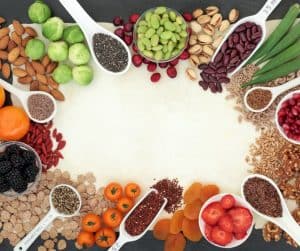
Anaemia caused by iron deficiency is a condition in which there is not enough iron to form enough healthy red blood cells of sufficient size to carry oxygen to the tissues of the body.
Iron plays a crucial physiological role in your body. But despite its importance, iron deficiency anaemia is still a common problem among female athletes. Iron deficiency can have major adverse effects on your well-being and your athletic capacity.
It’s not uncommon for iron deficiency anaemia to be quite mild and go unnoticed. But women – and especially active, athletic women – are very prone to this condition. If gone untreated, the anaemia will worsen, and the signs and symptoms will intensify.
Without enough iron, your body can’t produce enough hemoglobin – the substance in red blood cells that enables them to carry oxygen – and as a result iron deficiency anaemia can leave you short of breath, headachy, tired, and unable to complete a training session or event with your usual enthusiasm. Iron deficiency is missed in 47-82% of females and 95-100% of male adolescents and young adult patients.
10 signs of iron deficiency
*Fatigue that starts even after a good night’s sleep
*Restless legs
*Nausea
*Bruising
*Pale or itchy skin
*Hair loss
*Shortness of breath
*Poor concentration and decision-making, “foggy brain”
*Rapid heartbeat or “fluttering feeling”
*Headache, dizziness or light-headedness
Keep in mind this is just a small number of the 75 known symptoms of iron deficiency. Unusual cravings for non-nutritive substances, such as ice and dirt
CAUSES OF IRON DEFICIENCY
Low or little dietary intake of iron-rich foods is often blamed as the key factor contributing to iron deficiency. With plant-based eating increasing in popularity amongst the athlete community, this is a key factor for many athletes. Lack of awareness of how to consume foods that enhance iron absorption or knowledge on sources of plant-based iron-rich foods can render an athlete with symptoms in a matter of months. Poor intake however is not the only cause of iron deficiency anaemia.
*Blood loss. Blood contains iron within red blood cells. If you lose blood, you lose some iron. Women with heavy periods are at risk of iron deficiency anaemia because they lose blood during menstruation. Athletes who are frequent blood donors are at increased risk for iron deficiency.1 Athletes who regularly use nonsteroidal anti-inflammatories are likely to have increased gastrointestinal blood losses increasing their risk of iron deficiency3.
*An inability to absorb iron. Dietary iron is absorbed into the bloodstream through the small intestine. An intestinal disorder, such as celiac disease, stomach ulcers, ulcerative colitis or Crohn’s disease, which affects the intestine’s ability to absorb nutrients from digested food, can lead to iron-deficiency anaemia. If part of the small intestine has been bypassed or removed surgically, the ability to absorb iron and other nutrients will be reduced. Inflammation in the digestive tract is aligned with symptoms such as bloating, gas, diarrhoea or constipation, food intolerances, or loud gurgling, and may signal the integrity of the gut lining may be compromised. Without good integrity, absorption of nutrients is also reduced.
*Low stomach acid. Adequate stomach acid (hydrochloric acid- HCL) is required to break down minerals such as iron and extract them from the food we eat. Low stomach acid is a common issue following times of prolonged physical or emotional stress and can be found alongside iron deficiency.
*Iron stealers. Bacteria overgrowth, Helicobacter pylori, and parasites within the digestive tract can impact the way iron is absorbed and may contribute to blood loss, therefore, contributing to iron deficiency over time.
*Post natal– Without iron supplementation, iron deficiency anaemia occurs in many pregnant women due to the iron requirements of the mother and baby. Post-natal iron deficiency can occur as many women are naturally preoccupied with their new arrival and forget to have adequate medical checkups for themselves. Fatigue is often experienced by mother’s and therefore iron deficiency can go undetected for many months. This depletes not only the mother but also the baby’s supply of iron who depends on the mother for iron for the first 6 months of life until solids are introduced.
Hundreds of athletes have used our handy anaemia quiz to help determine the likely risk of having low iron or anaemia. Find out if you are getting low on iron here.
Want to know more? Contact the Athlete Sanctuary to learn how we can support you further.
About the Author: Kate Smyth is a Sports naturopath, nutritionist and female-centric running coach. She is the founder of the Athlete Sanctuary- a holistic healthcare clinic for athletes of all levels and sporting codes. Kate has a thirst for knowledge with two bachelor’s and a master’s degree under her belt. She has been involved in sports for many decades and competed for Australia in the Commonwealth Games and Olympic Games marathons with a personal best time of 2 hours 28 minutes. For more information visit https://athletesanctuary.com.au/kate-smyth
References

Kate Smyth is a sports naturopath, nutritionist and female-centric running coach. She is the founder of the Athlete Sanctuary – a holistic healthcare clinic for athletes of all levels and sporting codes.
Kate has a thirst for knowledge, with two bachelor’s and a master’s degree under her belt. She has been involved in sports for many decades and competed for Australia in the Commonwealth Games and Olympic Games marathons with a personal best time of 2 hours 28 minutes.
Targeted naturopathic care, nutrition and holistic coaching for active individuals.
Normatec Recovery systems- hire and purchase
Birregurra -28-30 Strachan Street,
Torquay- 20 Cantala Drive, Jan Juc
TELEHEALTH – Aus wide, New Zealand, Canada and globally (except US)
Melbourne and Ballarat clinics are currently online